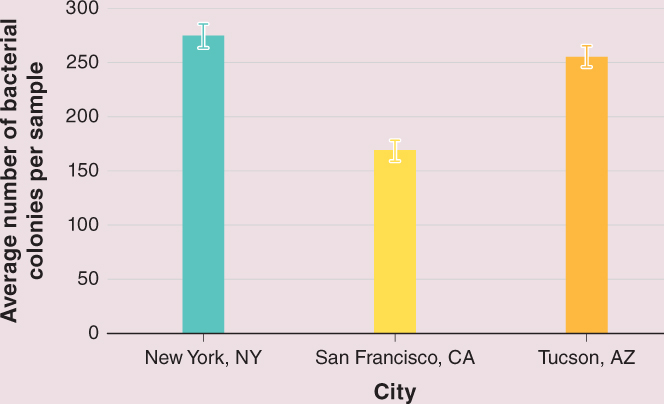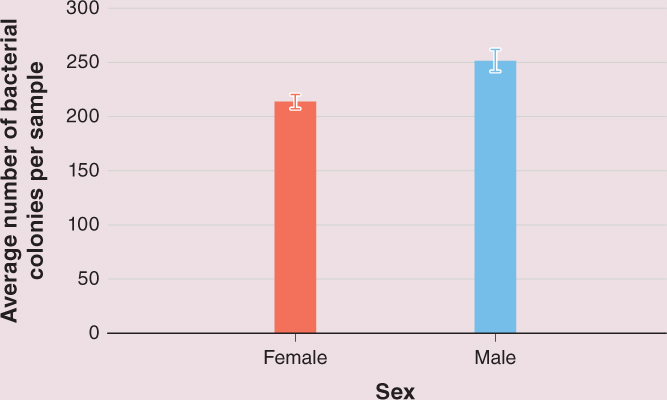Bacteria can live in a huge variety of habitats. As humans create new, “artificial” environments, do bacteria thrive in these habitats as well? Some researchers wondered, in particular, about the extent to which bacteria might be thriving in a habitat increasingly important to many people in the industrialized world: the office building. They noted that in crowded offices, with shared bathrooms, meeting rooms, and other common areas, bacteria might be brought in and shed in large numbers. So they decided to investigate.
To evaluate the abundance of office bacteria, where could you take samples?
Because they wanted to draw some general conclusions, the researchers decided to collect samples in three different cities. They chose Tucson, Arizona (where one of the researchers lived), New York, and San Francisco. And to avoid being overly influenced by any one office—
The samples were collected by wiping a cotton swab across a small (13 cm2) area of the desk. Each swab was stored in a sterile tube on ice and sent to the laboratory in Arizona. In the lab, the researchers swirled the swab in a sterile saline (saltwater) solution, and then rubbed it across the surface of a culture medium on a small Petri plate. The culture medium was a gel containing a nutrient broth in which bacteria could grow. They then kept the plate at 30° C (86° F) for five days, allowing any bacteria present to grow.
How could the researchers evaluate the abundance of bacteria in the different offices?
The researchers simply counted the number of colonies growing on each plate. After five days, colonies were visible to the naked eye. To evaluate any large-
What did they find?
The large number of samples they collected made it possible to find some clear and interesting results. First, they plotted the average number of colonies on the plates from each city:

They found a significant difference among the cities: San Francisco had the lowest number of colonies per sample (about 170), and New York had the highest (more than 275).
The researchers found an even more striking difference when they compared men’s and women’s desks:

545
The samples from men’s desks contained significantly more bacterial colonies (about 250, on average) than those from women’s desks (about 215).
What can we conclude from these results?
When these research results were first published in 2012, many newspapers jumped at the opportunity to proclaim that “men are grubbier than women.” This conclusion, after all, seemed to confirm previously published research reporting that men wash their hands and brush their teeth less frequently than women. But the researchers themselves were more conservative in the conclusions they drew.
Why might these results reflect something other than poorer hygiene in men?
The researchers pointed out that men are bigger than women, on average. So men have more skin surface and larger nasal and oral cavities. Consequently, they simply have more space for bacteria to colonize. And that, in turn, may lead to more bacteria being shed onto their desk surfaces.
Are there any other interesting or useful observations that you could make from this experimental approach?
This study was part of a larger project in which the researchers also looked at the variety of bacteria in each office. They found a broader diversity of bacterial types in Tucson than in the other two cities, but no difference in the diversity of bacteria living on women’s versus men’s desks.
Are there any practical consequences of these results?
An important result was that most of the bacteria they identified typically live on or in humans and are not harmful. The presence or absence of these bacteria probably has no health consequences.
Interestingly, the researchers noted that the Clorox Corporation provided some of the funding for this study. Although they clearly stated that the funders had no role in the study design or analysis, perhaps these methods will be used in the future to evaluate the effectiveness of various cleaning products or regimens.
TAKE-HOME MESSAGE 13.7
The abundance of bacteria in human habitats can be evaluated and compared, using simple swabbing and culturing methods. In office buildings, bacteria are extremely common, but with significant differences in abundance depending on the location of the office and the gender of its occupant.
Describe how researchers investigated whether bacteria might be thriving in office buildings.
The researchers wanted to draw some general conclusions, so they decided to collect samples in 3 different cities, selecting 30 office buildings in each city. Within each office, they sampled a small area on a desktop. They then cultured the bacteria in the laboratory and counted the colonies growing on each culture plate.